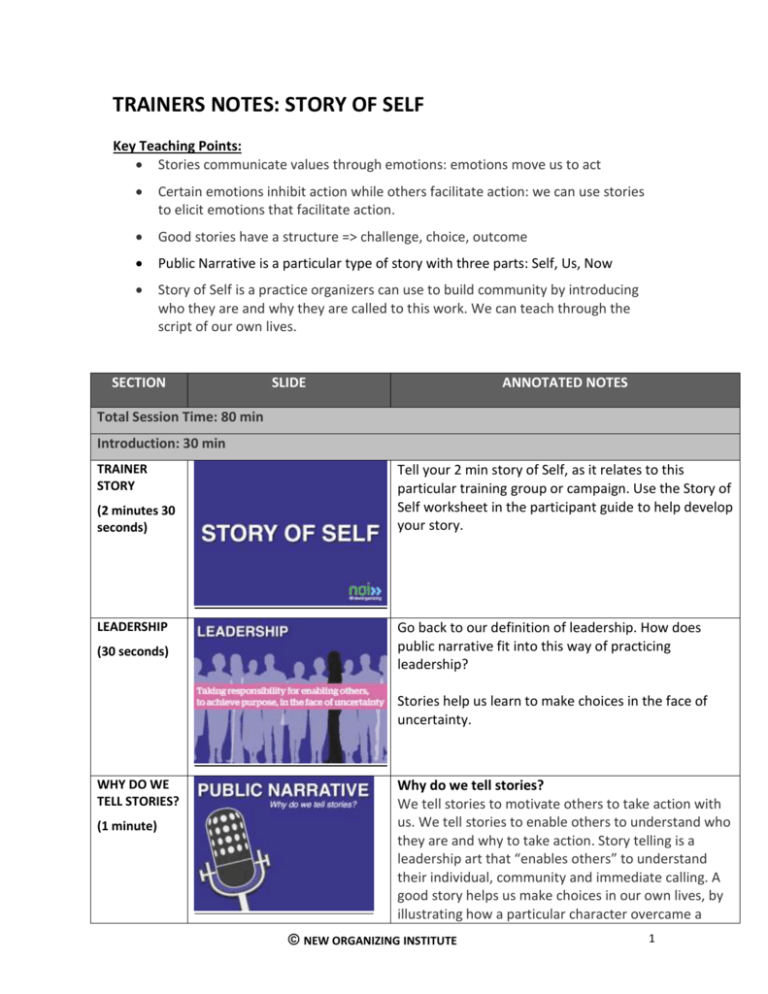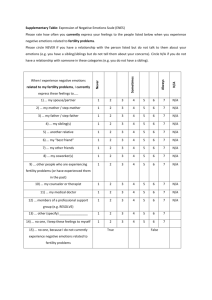trainers notes: story of self
advertisement

TRAINERS NOTES: STORY OF SELF Key Teaching Points: Stories communicate values through emotions: emotions move us to act Certain emotions inhibit action while others facilitate action: we can use stories to elicit emotions that facilitate action. Good stories have a structure => challenge, choice, outcome Public Narrative is a particular type of story with three parts: Self, Us, Now Story of Self is a practice organizers can use to build community by introducing who they are and why they are called to this work. We can teach through the script of our own lives. SECTION SLIDE ANNOTATED NOTES Total Session Time: 80 min Introduction: 30 min TRAINER STORY (2 minutes 30 seconds) LEADERSHIP (30 seconds) Tell your 2 min story of Self, as it relates to this particular training group or campaign. Use the Story of Self worksheet in the participant guide to help develop your story. Go back to our definition of leadership. How does public narrative fit into this way of practicing leadership? Stories help us learn to make choices in the face of uncertainty. WHY DO WE TELL STORIES? (1 minute) Why do we tell stories? We tell stories to motivate others to take action with us. We tell stories to enable others to understand who they are and why to take action. Story telling is a leadership art that “enables others” to understand their individual, community and immediate calling. A good story helps us make choices in our own lives, by illustrating how a particular character overcame a © NEW ORGANIZING INSTITUTE 1 challenge. TWO WAYS OF KNOWING (1 minute) There are 2 ways in which we understand the world around us: 1. The heart understands the ‘why’ (story) 2. The head understands the ‘how’ (strategy) Both lead to action, but we need to learn to lead with the head AND the Heart. Organizing without a strategy isn’t driven and doesn’t lead us anywhere, like walking blind. But having the best strategy in the world doesn’t matter if we’re not motivated to implement it and we can’t get anyone to join us. Audience Engagement: By show of hands, who here has been in an organizing situation that was all about head (strategy)? Like “lets get the petitions signed and then the meeting with the congressional members and then lets make calls, etc.” How’d it go? How about an organization that was all heart- storytelling, community building and no strategy? Emphasize the need for the head and the heart. EMOTIONS, VALUES, ACTION (1 minute) ACTION MOTIVATORS & INHIBITORS (2 minutes) Stories move us to action by engaging our emotions. Emotions tell us what we value in the world. What are the things that bring you joy & hope? What makes you feel angry? When we hear stories that make us feel a certain way those stories remind us of our core values. We experience our values through emotions. Then we are prepared to take action on those values. Audience Engagement: When I told my story earlier, how did it make you feel? What specific emotions did you feel? When? Why? What values did you hear in my story? Would it have been the same if I told you “ I value [insert value]” How did you experience those values? There are emotions that inhibit action and others that motivate us to act. Inertia, (no forward progress) Apathy (without caring), Fear, Isolation (fail to appreciate interest we share with others) & Self-doubt (I can’t do it)– explain the feelings Audience Engagement (Questions to Consider): © NEW ORGANIZING INSTITUTE 2 STORY STRUCTURE (1 minute) 3 PARTS OF PUBLIC NARRATIVE (1 minute) Has anybody felt these emotions before? Have they inhibited you from taking action? Have you seen a community with some of these feelings? What are the actions of a community that has these feelings? How do these feelings change? Just by saying, “don’t be afraid” or “you should care about this!” Our emotions of inaction don’t go away because some one tells us they should, but because we start to feel other emotions. Have you been in a moment that your community felt with URGENCY? Has anyone felt that in your communities – ANGER? Have you felt HOPE, SOLIDARITY AND YOU CAN MAKE A DIFFERENCE (YCMAD)? When specifically? What gives you that Hope, Solidarity, sense of YCMAD? Audience Engagement: What makes a story? Stories have a common structure. A Plot: something happens to the character, and then the character needs to make a choice, then that choice yields an outcome – and that outcome teaches a moral. What happens when there’s no challenge? What happens when the story is all challenge and there’s no outcome, or hope? In this session you will be learning how to tell your Story of Self, but since organizing isn’t just about your, but about you in relation to others, you will also be learning the two other parts of public narrative: the Story of US and Now. Three parts to public narrative: Story of Self (why I’m called to this work) Story of Us (why we’re called, why we matter in this effort) © NEW ORGANIZING INSTITUTE 3 Story of Now (what we’re called to do right now) Show DNC 2004 Convention Speech Trainer Tip: Because your audience may have differing political opinions, make sure to explain that we didn’t choose this video because Obama is a Democrat or the President, we use this video because he is one of the greatest speakers in our country and he moved many people to action. This a craft he learned and we are here to teach you the same craft. SAMPLE STORYBARACK OBAMA (15 min total to include 3 min set up, 7 min video and 5 min debrief) Video Debrief Debrief: Audience Engagement: How do you feel after hearing that? What specific stories or examples painted the challenge and choice for you? What did you want to know more of? Would it have had the same impact if he had said “ My name is Barack Obama, I went to Harvard Law school where I learned x and y. Then I was ran for Illinois State Senate, and won. I really support John Kerry because of x,y,z and you should too?” Where’s the story of self? Challenge, choice, outcome - focus on choice points (father's journey to US, parents decision to marry, naming "Barack") Notice that there is nothing about John Kerry in his speech, but rather a story that tells us about his own values. Then the audience trusts him and wants to support who he is supporting. What’s the transition? (“My story is part of the larger American story”) Where’s the story of us? Founding story, Declaration of Independence (why did he choose this?) Challenge, choice, outcome, hope What’s the transition? “We have more work to do” Where’s the story of now? Challenge, choice, outcome, hope Not statistics, but stories, no 10-point plann © NEW ORGANIZING INSTITUTE 4 LEARNING TEAMS EXPLANATION Review the Story of Self worksheets and learning team agenda before the groups break out. (5 minutes) Trainer Tip: Remind the participants to focus on 1 or 2 choice points in your life that teach others about what values move them to be here, and like a good movie their story should be constructed so we can SEE it, HEAR it, FEEL it because of the details. ROLEPLAY BREAK INTO TEAMS 65 min DEBRIEF 20 min All materials are in the participant guide Review agenda, Set Norms, assign a time keeper (10 min) Develop your story (10 min) Partner pair-and-share (15 min) Share stories in small group (30 min) Invite 2-3 participants to tell their stories. Have group coach them on making their stories better. Also, define what makes for effective coaching. What coaching questions helped your stories improve? Did they tell a real Story of Self with a clear moment(s) of choice? Did they avoid the trap of just talking about the campaign? If not how could they? What in their life are you still curious about? Was there good detail? Where could there be more? Coaching—what types of feedback & questions were helpful? © NEW ORGANIZING INSTITUTE 5







